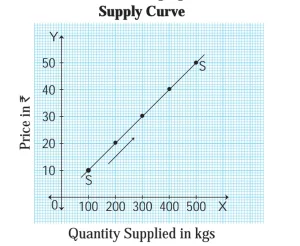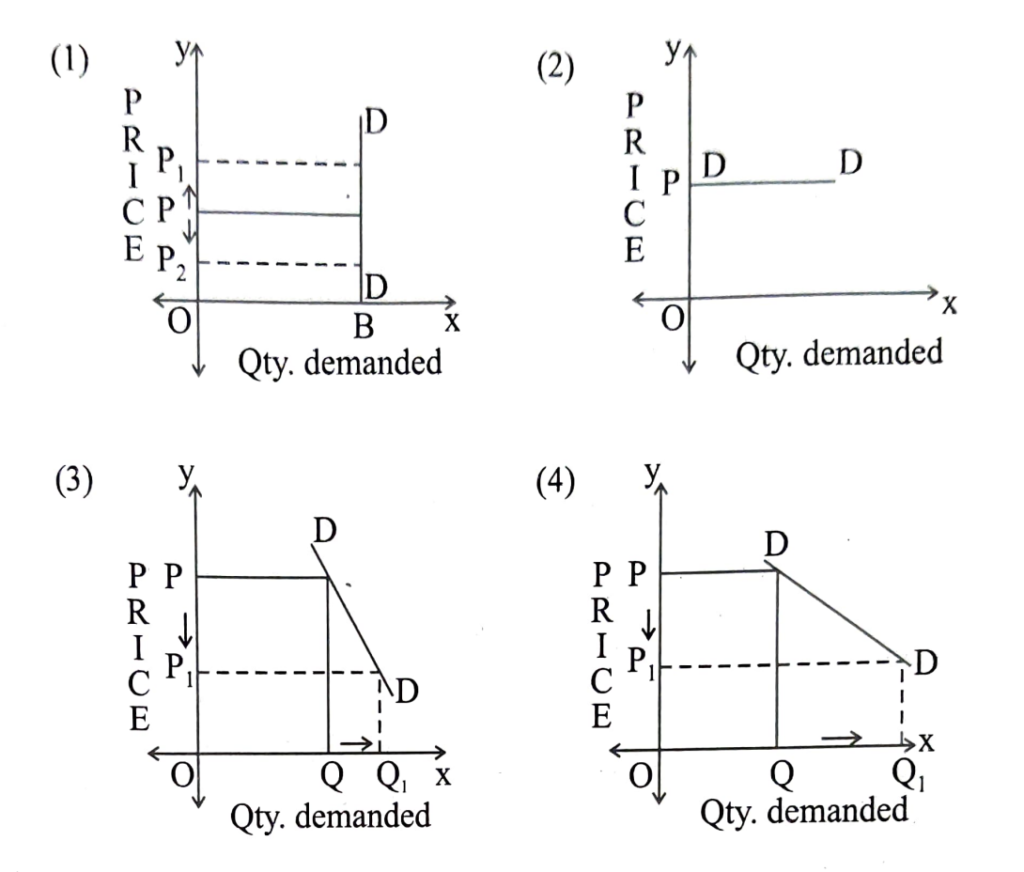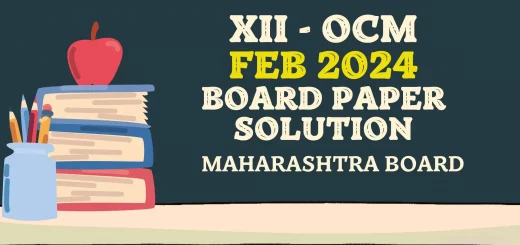HSC Economics Question Paper 2022 July with Solution | Maharashtra Board (Download Free PDF)
Table of Contents
HSC Economics Question Paper 2022 July with Solution

- 12th Commerce July 2022 Question Papers
- 12th Commerce March 2021 Question Papers
- 12th Commerce March 2022 Question Papers
- 12th Commerce March 2023 Question Papers
- 12th Commerce July 2023 Question Papers
- 12th Commerce Feb 2024 Question Papers
- 12th Commerce Feb 2025 Question Papers
HSC Economics Question Paper 2022
Q. 1. (A) Choose the correct option : (5) {20}
1) The branch of economics that deals with the allocation of resources.
a) Micro economics
b) Macro economics
c) Econometrics
d) None of these
Options :
1) a, b, and c
2) a and b
3) only a
4) None of these
2) Classification of market is done on the basis of place
a) Local market, National market, International market
b) Very short period market, Local market, National market.
c) Short period market, National market, International market.
d) Local market, National market, Short period market.
Options :
1) a, b and c
2) b, c and d
3) only a
4) a and d
3) Statements that are incorrect in relation to index numbers.
a) Index number is a geographical tool.
b) Index numbers measure changes in the air pressure.
c) Index numbers measure relative changes in an economic variable.
d) Index numbers are specialized averages.
Options :
1) c and d
2) a and b
3) b and c
4) a and d
4) Non-tax sources of revenue:
a) Direct and Indirect Tax
b) Direct Tax and Fees
c) Fees
d) Special Levy
Options :
1) b and c
2) a and c
3) a, b, c and d
4) c and d
5) Methods of quantitative credit control:
a) Bank rate
b) Open market operation
c) Cash reserve ratio
d) Credit rationing
Options :
1) a, b, c
2) b, c, d
3) a, b, d
4) a, c, d
(B) Complete the correlation: (5)
i) Micro economics : Tree : : Macro economics : Forest
ii) Price and demand for normal goods : Inverse relationship : : Giffen goods : Direct relationship
iii) Perfect competition : Many sellers : : Monopoly : Single seller
iv) Total revenue : Quantity x Price : : Average revenue : Total revenue/Total quantity
v) Output method : Inventory Method : : Income method : Factor cost method
(C) Find the odd word out: (5)
i) Types of elasticity of demand – Price elasticity, Income elasticity, less elastic, Cross elasticity.
ii) External debt – Foreign Banks, World Bank, International Bank, Central Bank
iii) Organised sector – Money lender, Commercial bank, Co-operative Bank, Reserve Bank of India
iv) Transfer income – Pension, unemployment allowance, wages, gifts
v) Types of foreign trade – Local trade, Import trade, Export trade, Entrepot trade.
(D) Complete the following statements: (5)
i) The relationship between demand for a good and price is ________.
a) direct
b) inverse
c) no effect
d) can be direct and inverse
ii) Demand curve is parallel to X-axis, in the case of _____.
a) perfectly elastic demand
b) perfectly inelastic demand
c) relatively elastic demand
d) relatively inelastic demand
iii) A rightward shift in supply curve shows _____.
a) contraction of supply
b) decrease in supply
c) expansion of supply
d) increase in supply
iv) Trade of goods and services within the geographical boundaries of a nation.
a) International trade
b) Internal trade
c) Currency trade
d) Inter-continental trade
(v) Stock exchange is an important constituent of the _______.
a) Capital market
b) Money market
c) Local market
d) International market
Q. 2. (A) Identify and explain the following concepts : (Any 3) (6) [12]
(i) Salma purchased a sweater for her father in the winter season.
Identified Concept: Time Utility
Explanation: When the utility of a commodity is derived with a change in its time of utilization, it is called time utility.
(ii) Sanket’s demand for consumer goods increased by 20% due to an increase in his income by 50%
Identified Concept: Income Elasticity of demand
Explanation: The income elasticity of demand measures how the change in a consumer’s income affects the demand for a specific product.
(iii) Anita receives a monthly pension of Rs 15,000/- from the State Government.
Identified Concept: Transfer Income
Explanation: Transfer income refers to the income received without rendering any productive service in return.
(iv) John produces 5 units of mobile in his factory at Rs 50,000. When he produced the 6th unit of a mobile his total cost was Rs 58000.
Identified Concept: Marginal Cost
Explanation: The marginal cost refers to the increase in production costs generated by the production of additional product units.
(v) Samir paid wages to workers in his factory and interest on his Bank Loan.
Identified Concept: Fixed Deposit
Explanation: Fixed deposits refer to those deposits that are held for a fixed period of time. These deposits cannot be withdrawn before the maturity period.
Q. 2. (B) Distinguish between (Any 3) (6)
(i) Individual Demand and Market Demand
| Individual Demand | Market Demand |
| Individual demand is the quantity of a commodity demanded by a consumer at a given price during a given period of time. | Market demand is the total demand for a commodity from all the consumers at a given price during a given period of time. |
| Individual demand is always less than market demand. | Market demand is always greater than Individual demand. |
(ii) Slicing method and Lumping method
| Slicing method | Lumping method |
| It splits or divides the whole economy into small individual units and then studies each unit separately in detail. | Lumping method is the study of the whole economy rather than its part. |
| Macroeconomics uses lumping method. | Macro economics uses lumping method. |
(iii) Stock and Supply.
| Stock | Supply |
| Stock is the total quantity of commodities available for sale with a seller at a particular point of time. | The word ‘supply’ implies the various quantities of a commodity offered for sale by producers during a given period of time at a given price. |
| Normally, stock exceeds supply but in the case of perishable goods stock may be equal to supply. | Supply and stock can be same, but supply cannot exceed stock. |
(iv) Simple Index Number and Weighted Index Number
| Simple Index Number | Weighted Index Number |
| In this method, every commodity is given equal importance. | In this method, suitable weights are assigned to various commodities. It gives relative importance to the commodity in the group. |
| It is the easiest method of constructing index numbers. | It is a comparatively complex method of constructing index numbers. |
| This method can be applied to determine 1) Price Index Number 2) Quantity Index Number 3) Value Index Number | There are various methods of constructing weighted index numbers such as Laaspeyre’s Price Index, Paasche’s Price Index etc. |
(v) Direct Tax and Indirect Tax.
| Points | Direct Tax | Indirect Tax |
| 1)Meaning | Direct tax is paid by an individual directly to the government. A taxpayer cannot transfer this liability to another entity or person. | An individual pays indirect tax to the government but through an intermediary. This intermediary then passes it on to the government. |
| 2) Examples | For example – personal income tax, wealth tax, etc. | Goods and Services Tax [GST] |
| 3) Nature of tax | Progressive tax, i.e., its rate increases with taxpayer’s income. | Regressive tax, i.e., its rate decreases with increase in income. |
Q. 3. Answer the following : (Any 3) (12)
(i) Explain any four features of Microeconomics.
Answer:
“Microeconomics is in fact a microscopic study of the economy.”
Features of Microeconomics :
1) Study of Individual Units:
Microeconomics is the study of the behavior of small individual economic units, such as an individual firm, individual price, individual household, etc.
2) Price Theory:
Microeconomics deals with the determination of the prices of goods and services as well as factors of production. Hence, it is known as price theory.
3) Partial Equilibrium:
Equilibrium is the balance between two factors. The microeconomic analysis deals with partial equilibrium which analyses the equilibrium position of an individual economic unit i.e. individual consumer, individual firm, individual industry etc.
4) Based on Certain Assumptions:
Microeconomics begins with the fundamental assumption, “Other things remaining constant” (Ceteris Paribus) such as perfect competition, laissez-faire policy, pure capitalism, full employment, etc. These assumptions make the analysis simple.
5) Slicing Method:
Microeconomics uses the slicing method. It splits or divides the whole economy into small individual units and then studies each unit separately in detail. For example, a study of individual income out of national income, a study of individual demand out of aggregate demand, etc.
(ii) Explain any four points related to the significance of index numbers.
Answer: Index numbers are indispensable tools of economic analysis.
The following points explain the significance of index numbers:
1) Framing suitable policies:
Index numbers provide guidelines to policymakers in framing suitable economic policies such as agricultural policy, industrial policy, fixation of wages and dearness allowances in accordance with the cost of living, etc.
2) Studies trends and tendencies:
Index numbers are widely used to measure changes in economic variables such as production, prices, exports, imports, etc. over a period of time.
3) Forecasting about future economic activity:
Index numbers are useful for making predictions for the future based on the analysis of past and present trends in economic activities. For example, based on the available data pertaining to imports and exports, future predictions can be made.
4) Measurement of inflation:
Index numbers are also used to measure changes in the price level from time to time. It enables the government to undertake appropriate anti-inflationary measures.
5) Useful to present financial data in real terms:
Deflating means making adjustments to the original data. Index numbers are used to adjust price changes, wage changes, etc. Thus, deflating helps to present financial data in real terms (at constant prices).
(iii) Explain any four features of monopoly.
Answer: The term monopoly is derived from the Greek word ‘Mono’ which means single and ‘poly’ which means the seller. A monopoly is a market in which there is only one seller who controls the entire market supply for a product that has no close substitute.
The following are the main features of the monopoly market:
1) Single seller:
In a monopoly, there is no competition as there is only one single producer or seller of the product. But, the number of buyers is large.
2) No close substitute:
There are no close substitutes for the product of the monopolist. Therefore, the buyers have no choice. They have to either buy the product from the monopolist or go without it. The cross elasticity of demand for his product is either zero or negative.
3) Barriers to entry:
Entry of the rivals is restricted due to legal, natural, and technological barriers which do not allow the competitors to enter the market.
4) Complete control over the market supply:
The monopolist has a complete hold over the market. He is the sole producer or seller of the product.
5) Price maker:
A monopolist can fix the price of his own product as he controls the whole market supply. Monopolists a price makers.
6) Price discrimination:
A monopolist being a price maker, can charge different prices to different consumers for the same product, on the basis of time, place, etc. Thus, price discrimination is an important feature of a monopoly market. For example, students and senior citizens are provided railway tickets at concessional rates.
7) No distinction between firm and industry:
A monopolist is the sole seller and producer of the product. A monopoly firm itself is an industry.
(iv) Explain any four points related to the role of the money market in India.
Answer: A money market is a market for lending and borrowing short-term funds. It is a market for “near money” i.e. short-term instruments such as trade bills, government securities, promissory notes, etc.
The following points outline the role of the money market in India:
1) Short-term requirements of borrowers:
The money market provides reasonable access for meeting the short-term financial needs of the borrowers at realistic prices.
2) Liquidity Management:
The money market is a dynamic market. It facilitates better management of liquidity and money in the economy by the monetary authorities. This, in turn, leads to economic stability and the development of the country.
3) Portfolio Management:
The money market deals with different types of financial instruments that are designed to suit the risk and return preferences of the investors. This enables the investors to hold a portfolio of different financial assets which in turn, helps in minimizing risk and maximizing returns.
4) Equilibrating mechanism:
Through the rational allocation of resources and mobilization of savings into investment channels, the money market helps to establish an equilibrium between the demand for and supply of short-term funds.
5) Financial requirements of the Government:
The money market helps the Government to fulfill its short-term financial requirements on the basis of Treasury Bills.
v) Explain any four points related to the role of foreign trade.
Answer: Foreign Trade is trade between the different countries of the world. It is called as International
Trade or External Trade.
The role of foreign trade can be justified on the basis of the following points:
1) To earn foreign exchange:
Foreign trade provides foreign exchange which can be used for very productive purposes. Foreign trade is a remarkable factor in expanding Foreign Trade in India the market and encouraging the production of goods.
2) Encourages Investment:
Foreign trade creates an opportunity for the producers to reach beyond the domestic markets. It encourages them to produce more goods for export. This leads to an increase in total
investment in an economy.
3) Division of labour and specialization:
Foreign trade leads to the division of labour and specialization at the world level. Some countries have abundant natural resources, they should export raw materials and import finished goods from countries that are advanced in skilled manpower. Thus, foreign trade gives benefits to all countries thereby leading to the division of labour and specialization.
4) Optimum allocation and utilization of resources:
Due to specialization, resources are channelized for the production of only those goods that would give the highest returns. Thus, there is rational allocation and specialization of resources at the international level due to foreign trade.
5) Stability in price level:
Foreign trade helps to keep the demand and supply position stable which in turn stabilizes the price level in the economy.
Solution of other subjects
Solution of all Chapters of Economics
1 – 2 – 3A – 3B – 4 – 5 – 6 – 7 – 8 – 9 – 10
Q. 4. State with reasons whether you agree or disagree with the following statements (Any 3) (12)
(i) Every desire of an individual is a demand.
Answer: No, I disagree with this statement.
Reason:
a) In ordinary language, demand means a desire.
b) Desire means an urge to have something.
c) In Economics, demand means a desire which is backed by willingness and ability to pay.
d) E.g.: if a person has the desire to go on a vacation to Mauritius, but does not have the money to go there, then it will simply be a desire and not a demand in an economic sense. Thus, demand is an effective desire.
e) Demand = Desire + Ability to pay + Willingness to spend
f) Therefore, Every desire of an individual is not demand
(ii) There is a direct relationship between price and quantity supplied.
Answer: Yes, I agree with this statement.
Reason:
a) The law of Supply states that “Other things being constant, higher the price of a commodity, more is the quantity supplied and lower the price of a commodity, less is the quantity supplied.
b) In simple words, higher the price, higher the supply, and lower the price, lower the supply.
c) The supply curve graphically represents this relationship between price and supply. It has a positive slope i.e. it slopes upward from left to right.

e) Therefore, there is a direct relationship between price and quantity supplied.
(iii) Commercial banks perform various functions.
Answer: Yes, I agree with this statement.
Reason:
a) Accepting deposits: The basic function of commercial banks is to accept deposits from customers. These deposits are of the following types:
i) Saving accounts (ii) Current account (iii) Fixed deposit
b) Granting loans and advances: The second most important function of commercial banks is to give loans and advances.
c) Agency functions: Commercial banks perform various agency functions such as Transfer of funds, Collection of funds, etc.
d) Discounting bills of exchange: Commercial Banks provide financial assistance to the business community by discounting bills of exchange.
e) Credit creation: Commercial banks create credit in the economy through demand deposits. Credit creation paves the path for the growth of the economy.
f) Thus, Commercial banks perform various functions.
(iv) Index numbers can be constructed without the base year.
Ans: No, I disagree with this statement.
Reason:
a) An index number is a device to measure changes in an economic variable over a period of time.
b) Base year is the year against which comparisons are made.
c) Base year is also called the reference year. The base year should be normal i.e. it should be free from natural calamities. It should not be too distant in the past.
d) Therefore, Index numbers cannot be constructed without the base year.
(v) Slope of relatively elastic demand curve is steeper.
Answer: No, I disagree with this statement.
Reason:
a) Relatively elastic demand has a flatter curve because the percentage change in quantity demanded is greater than a percentage change in price.
b) The slope of demand is steeper in case of relatively inelastic demand the price may increase or decrease but the quantity demanded will near about remain the same.
c) Thus, Slope of relatively elastic demand curve is steeper.
Q. 5. Study the following table, figure, passage and answer the questions given below it (Any 2): (8)
(i)
| Price of Apple (Per Kg Rs) | Demand (Per Kg) | Supply (Per Kg) |
| 100 | 50 | 10 |
| 200 | 40 | 20 |
| 300 | 30 | 30 |
| 400 | 20 | 40 |
| 500 | 10 | 50 |
(1) Complete the above table. (2)
(2) Draw an equilibrium price determination diagram based on the above table. (2)
(ii) The following diagram is a linear demand curve. on the basis of the above diagram answer the following questions:

1) Demand at point ‘P2‘ is relatively inelastic. is this statement true or false?
2) Identify the elasticity of demand at point ‘P’.
3) What is denoted on ‘X’ axis in the above diagram?
4) Which method of measuring the elasticity of demand is denoted in the above diagram?
(iii)
As per a survey conducted by Galaxy Enterprise, it was observed that in Panji there was an increase in the demand for biscuits. This was due to the change in people’s tastes and habits.
Considering this an opportunity, the Galaxy enterprise borrowed capital from ‘Bank of India’, purchased wheat from farmers, and started producing biscuits. The company had a competition from Andromeda Foods Ltd. a producer of cream biscuits. One more research conducted by Galaxy Enterprise made them realize that with the rise in demand for biscuits,
the demand for tea has also increased.
Galaxy Enterprise started a chain of tea shops in Panji with the intention of creating competition with Andromeda.
(1) Find out the examples of types of demand from the above passage: (2)
(a) Direct Demand
Answer:
i) Increase in loan disbursement in urban and rural areas.
ii) Agriculture and retail traders started getting more loans.
(b) Indirect Demand
Answer:
(2) Give your opinion with reference to the above passage. (2)
Answer:
Banks provide different types of services like safe deposit lockers, D-mat facilities, internet banking, mobile banking, etc.
Q. 6. Answer the following questions in detail: (Any 2) (16)
i) State and explain the law of diminishing marginal utility with exceptions.
Answer: The Law of DMU: This law was first proposed by Prof. Gossen but was discussed in detail by
Prof. Alfred Marshall in his book ‘Principles of Economics’ published in 1890.
Statement of the Law :
According to Prof. Alfred Marshall, “Other things remaining constant, the additional benefit which a person derives from a given increase in his stock of a thing, diminishes with every increase in the stock that he already has.” In short, the more of a thing you have, the less you want to have more of it.
The below table explains the Law of Diminishing Marginal Utility.
| Units of Commodity x | Marginal Utility (MU) |
| 1 | 10 |
| 2 | 8 |
| 3 | 6 |
| 4 | 4 |
| 5 | 2 |
| 6 | 0 |
| 7 | -2 |
The table shows that marginal utility keeps on diminishing with an increase in consumption, further it becomes zero and then negative.

Explanation of the Diagram :
In the above diagram, units of commodity x are measured on X-axis, and marginal utility is measured on Y-axis. Various points of MU are plotted on the graph as per the given schedule. When the locus of all the points is joined, the MU curve is derived. MU curve slopes downwards from left to right which shows that MU goes on diminishing with every successive increase in the consumption of a commodity. When MU becomes zero, the MU curve intercepts the X-axis. Further consumption of a commodity brings disutility (negative utility) which is shown by the shaded portion in the diagram.
Exceptions to the Law of Diminishing Marginal Utility :
Following are the exceptions to the law of diminishing marginal utility :
1) Hobbies:
In certain hobbies like collections of various stamps and coins, rare paintings, music, reading, etc., the law does not hold true because every additional increase in the stock gives more pleasure. This increases
marginal utility. However, this violates the assumption of homogeneity and continuity.
2) Miser:
In the case of a miser, every additional rupee gives him more and more satisfaction. The marginal utility of money tends to increase with an increase in the stock of money. However, this situation ignores the assumption of rationality.
3) Addictions:
It is observed in the case of a drunkard that the level of intoxication increases with every additional unit of liquor consumed. So MU received by drunkards may increase. Actually, it is only an illusion. This condition is similar to almost all addictions. However, this violates the assumption of rationality.
4) Power:
This is an exception to the law because when a person acquires power, his lust for power increases. He desires to have more and more of it. However, this again violates the rationality assumption.
5) Money:
It is said that the MU of money never becomes zero. It increases when the stock of money increases. This is because money is a medium of exchange that is used to satisfy various wants. However, according to some economists, this law is applicable to money too. For example, the marginal utility of money is more to a poor person than to a rich person.
(ii) Explain the concept of National income and explain the features of National Income.
Answer:
The modern economy is a money economy. Hence, the national income of a country is expressed in terms of money. The total income of the nation is called national income.
In real terms, national income is the flow of goods and services produced in an economy during a year.
According to NIC “A national estimate measures the volume of commodities and services turned out during a given period counted without duplication.”
The following are the features of National Income :
1) Macro Economic concept:
National income represents the income of the economy as a whole rather than that of an individual. Hence it is a macroeconomic concept.
2) Value of only final goods and services:
In order to avoid double-counting in national income, the value of only final goods and services produced in the economy is considered. The value of intermediate goods or raw materials is not considered. For example, while estimating the production of shirts, there is no need to take the value of cotton, as it is already included in the price of the shirts.
3) Net aggregate value:
National income includes net value of goods and services produced and does not include depreciation cost. (i.e. wear and tear of capital assets)
4) Net income from abroad:
National income includes net income from abroad i.e. difference between export value and import value (X-M) and the net difference between receipts from abroad and payments made abroad (R-P).
5) Financial year:
National income is always expressed with reference to a time period. In India, it is from 1st April to 31st March.
6) Flow concept:
National income is a flow concept as it shows the flow of goods and services produced in the economy during a
year.
7) Money value:
National income is always expressed in monetary terms. It represents only those goods and services which are
exchanged for money.
(iii) Explain various reasons for the growth of public expenditure.
Answer: It is observed that there is a continuous growth in public expenditure in a developing country like India.
Following are some of the important reasons :
1) Increase in the Activities of the Government:
The modern government performs many functions such as the spread of education, public health, public works, public recreation, social welfare schemes, etc. It is observed that new functions are continuously being undertaken and old functions are being performed more efficiently on a large scale by the government. This leads to an increase in public expenditure.
2) Rapid Increase in Population:
The population of developing countries like India is increasing fast. In the 2011 Census, it was 121.02 crores. As a result, the government has to incur greater expenditure to fulfill the needs of the increasing population.
3) Growing Urbanization:
The spread of urbanization is a global phenomenon of the day. This leads to an increase in the government expenditure on water supply, roads, energy, schools and colleges, public transport, sanitation, etc.
4) Increasing Defence Expenditure:
In modern times, defence expenditure of the government is increasing even in peacetime due to unstable and hostile international relationships.
5) Spread of Democracy:
The majority of the countries in the world are democratic in nature. A democratic form of government is expensive due to regular elections and other such activities. This results in an increase in the total expenditure of the government.
6) Inflation:
Just like a private individual, the government has to buy goods and services from the market for the spread of economic and social development. Normally, prices show a rising trend. Due to this, the government has to incur increasing costs.
7) Industrial Development:
Industrial development leads to an increase in production, employment, and overall growth in the economy. Hence, the government makes huge efforts to implement various schemes and programs for industrial development. This results in an increase in government expenditure.
8) Disaster Management:
Many natural and man-made calamities like earthquakes, floods, cyclones, social unrest, etc. are occurring more frequently. The government has to spend a huge amount on disaster management which increases total expenditure.
Modern governments are working for the ‘welfare state’. Hence, there is a continuous increase in public expenditure.
Solution of other subjects
Solution of all Chapters of Economics
1 – 2 – 3A – 3B – 4 – 5 – 6 – 7 – 8 – 9 – 10
- 12th Commerce July 2022 Question Papers
- 12th Commerce March 2021 Question Papers
- 12th Commerce March 2022 Question Papers
- 12th Commerce March 2023 Question Papers
- 12th Commerce July 2023 Question Papers
- 12th Commerce Feb 2024 Question Papers
- 12th Commerce Feb 2025 Question Papers
Check out other posts related to the 12th Commerce
Online lectures of Class 12 Commerce
🔗 Share our videos and channel with your friends, and help us grow this channel.
Learn the Chapters of Accounts from our playlist.


